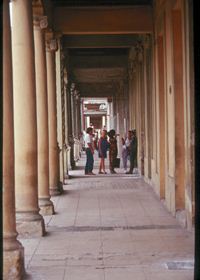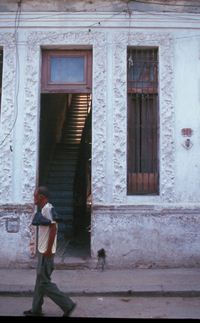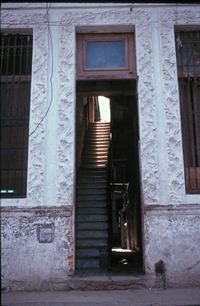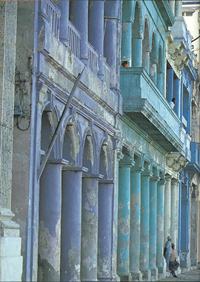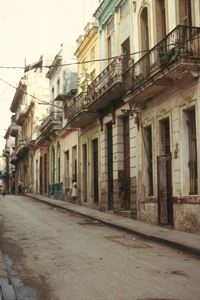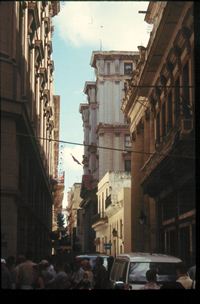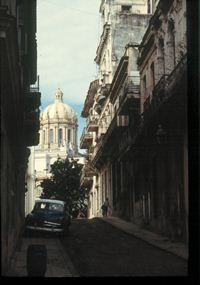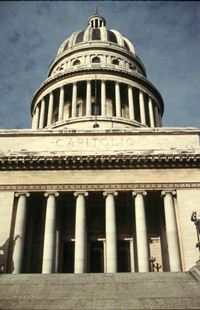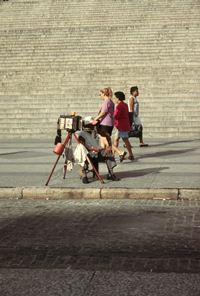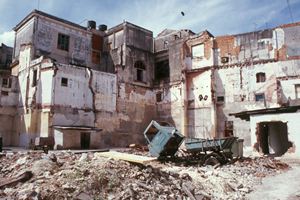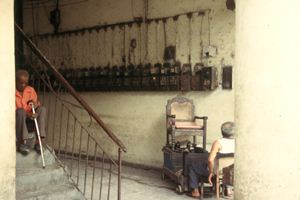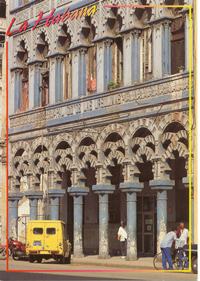Havana II
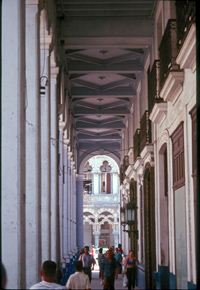
Diary, 20th October 1998:
Woke up, haven’t been able to sleep very well. Mark and I had breakfast together and then I went for a walk around the city by myself. I walked for miles. Usually on the pavement just beyond the shade of the continuous ribbon of covered galleries which is the great legacy of Spanish Urban Planning. Sometimes I walked through the galleries themselves soaking up the endless syncopation of classical columns, each of the slightly different and all of them the same. Within the galleries there are empty shops. Men behind little tables set up in the gallery space offer very specialised electrical services as part of the eternal liturgy of maintenance. Other men, bent, sit behind their tables offering insecticides and other objects, many of them mysterious. Bakeries produce white buns. I walked past the side of a large institutional building. It was dark inside, lots of people behind desks near the broken windows. I turned the corner and the institutional building turned into the grand classical entrance to an early twentieth century hospital.
I walked along a large, tree-lined avenue and had begun to think that “taxi?” might be a form of greeting. Everyone says it to me, quite politely, quite urgently. Walking along the road I get the most tantalising glimpses of the interiors of buildings, always dark, large and empty, bright blue or white walls with easy pictures and plastic gold, women entranced by mysterious rites and visions of Jesus with a large blood red heart on his chest. I left the tree-lined avenue and immersed myself in the residential blocks in Centro Havana. Here and there buildings have collapsed of simple exhaustion. The peeling paint has left a rich mosaic of fading colours on the facades. Ornaments under the coffin-like balconies have become pasty. Doorways lead through dark corridors to light courtyards, which have become blocked by internal subdivision, opportunistic extension or been made labyrinthine by the addition of rickety staircases. Quiet people live outside. Occasionally the smell of sewage wells up from the depths of somewhere. Garbage is efficient here. There is very little waste in it. When Garbage reaches the street it is truly finished, it will have no more use for humans, it will have been exhausted. I emerged near the Capitol in the Plaza de Fraternita. Just before I arrived there, I had been given a hateful stare by a woman surrounded by young men. I do not know what she said to me, but I felt that she did not want me snooping around. Perhaps she resented my presence in her squalor, but that is me thinking. I don’t know what she wanted, or did not want.
The Capitol is very distant from the residential blocks immediately surrounding it, buffered by emptiness. I walked down to the water’s edge near the old presidential palace with its enormous windows. I wanted to take a slide of a simple little neo-classical building just across from the Presidential palace, near the water’s edge. The city well it was. I was accosted there by a thin, gold-toothed ugly little girl who told me it was her birthday. She was accompanied by a sharp, taut, aggressive little man, who wanted to practise his English for five minutes in a particular bar and would I come along. He practised his English, but I did not want to accompany him to his bar and I congratulated the girl. “Just five minutes” he said and wanted to become threatening. I walked off and went into a street in Habana Vieja called Habana. I walked its entire length. The two-storey houses crowd the narrow street, leaving only a narrow pavement.
The dereliction of this part of the city is saddening. Balconies everywhere have become storerooms for anything that might be remotely useful: barrels, old pieces of flotsam, self-made shading devices strung with washing. Men and women sit on the doorstep conversing. Occasionally I receive a suggestive glance from a lady; I am a walking landmark of otherness. An old man limps up to me and shakes my hand. His smile is cavernous, stained teeth squeeze the life out of a fat dark brown water-logged cigar. He asks me where I am from. Jamaica, I say. “What? But you are not Black. Well. I say, before I came from Jamaica, I came from Holland. “Ah” He said. “Do you have a Jamaican coin?” Yes I said and gave him one. He looks at me questioningly, wondering if I had misunderstood and then let me go. A woman with man’s hips and flat buttocks and indifferent breasts is arguing loudly with an ugly man in a dark doorway. I wouldn’t have mentioned her indifferent attributes if they had not been the focus of her dress. They ignored me completely. Girls laugh and hiss at me. I look around. One of them looks at me with a penetrating look. She shakes her hair and smiles.
The street goes on for ages. The buildings behind their façades are full to the brim, subdivided to their limit, bursting with people. Some streets are blocked by the rubble from collapsed buildings: urban exhaustion. I emerge near the station in the southern and poorest part of Havana Vieja and walk back up north along the broad avenue marking the old walls of the city. A girl from behind the dark rear window of an enormous old American car blows me a kiss. I smile at her and walk on, negotiating the pavement. A small two-year old boy pees through the metal front door grill onto the pavement. He hasn’t pulled his trousers down properly and it all goes desperately wrong. It is a long walk back to the hotel Capri. I get lost again, but eventually arrive and have a shower in my bathroom.
During the afternoon we have a bus to take us round the city. A historian called Maria Victoria takes us through the landmarks and warbles continuous streams of facts and figures, which I translate for the benefit of the students who quickly switch off and enjoy the ride. Mark and I had dinner at “Monseigneur” just across from the Hotel Capri in a basement full of plastic marble and plastic columns, deep red swathes of cloth and a piano which breathes muzak over our conversation.
Walking back the short distance, a small group of Cubans stopped us with loud noises. A large man held a bottle of rum out to me and wanted me to drink. I politely declined. They did not ask Mark. Mark looks Cuban. Another man, old and crumpled said in broken English “Fuck you, you drink”. I laughed and lied “I don’t drink alcohol” “Es mi compleaño” I took a swig and pulled a dirty face and toasted his birthday. They laughed and we walked on.
While we were wandering around the large Waldorfian Hotel Nacional a tall thin black girl with bad skin and unhealthy eyes, brushed past me and grabbed the upper part of my thigh. I jerked and looked around. She smiled at me coyly.
